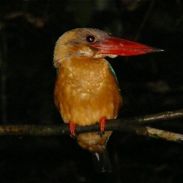In the earlier post on sleeping birds, Lena Chow brought up the subject of sleep in birds.
In all except one of the birds she encountered during her night trip down the Menanggul tributary, they were “sleeping with their eyes open. The Blue-eared Kingfisher (Halcyon capensis) was ‘blinking’ once in a while, but otherwise had its eyes fully open. Despite their eyes being open, I think they were not conscious of our presence as we approached within touching distance and torches were shone at them,” recounted Lena. The one she believes to be sleeping with its eyes closed was one of the two White-chested Babblers (Trichastoma rostratum) that was curled up into a furry ball.
According to Gill (2006), “Birds typically close their eyes when they sleep, but just one eye at a time for unihemispheric sleep. Unihemispheric sleep enables continued vigilance.” This type of sleep is termed slow-wave sleep or SWF and “requires the use of one side of the brain at a time, a primary feature of bird sleep.”
There is another type of sleep, the rapid-movement sleep, or REM, as seen in mammals. Here, both eyes are closed. In birds, very short and frequent bouts of REM sleep are common. Those swifts and terns that sleep on the wing indulge in “Quick bouts of REM sleep combined with (one-eyed) unihemispheric sleep”.
And birds also dream – but that is another story…
Image of the Stork-billed Kingfisher (Halcyon capensis), with its eyes fully open is by Lena Chow.
Reference:
Gill, F. B., 2007. Ornithology. W. H. Freeman & Co., New York. 758 pp.










3 Responses
Thаnks for fіnally talking about >Do birds sleep with their eyes cⅼosed?
– Bird Ecology Ѕtudy Group <Loved it!